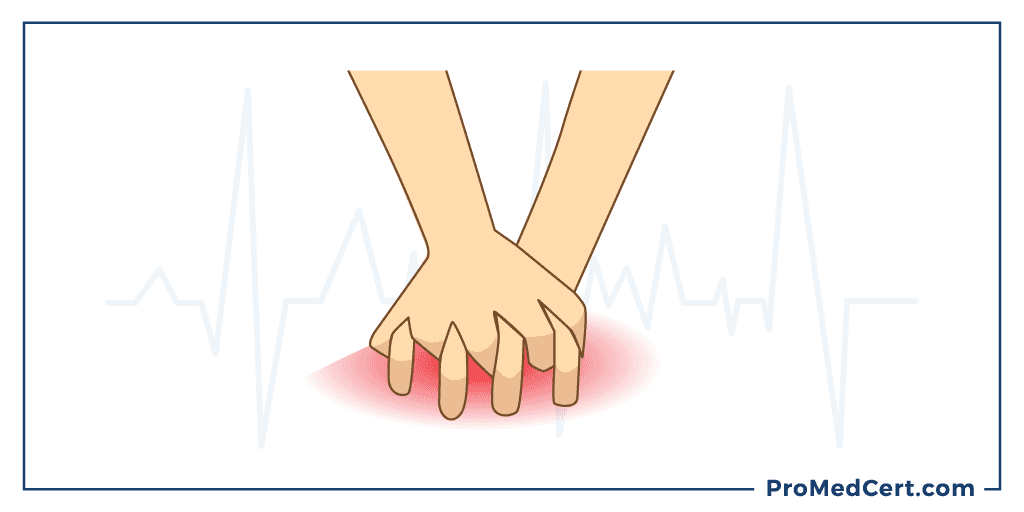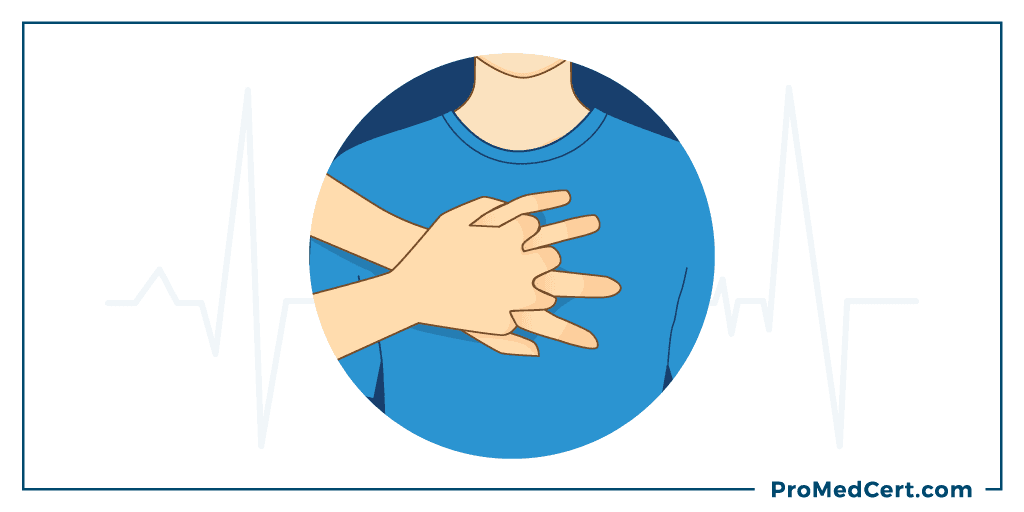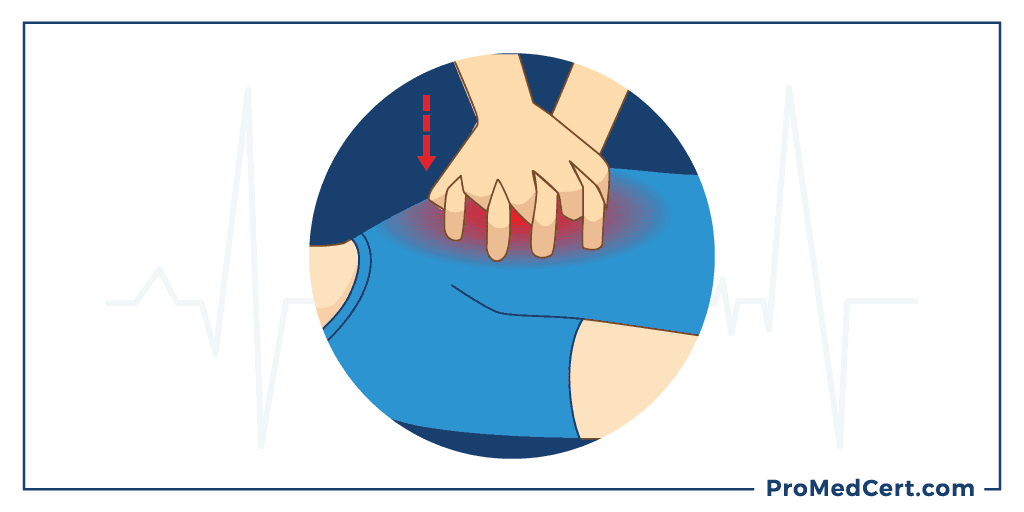Chest Compressions 101: How Deep and at What Rate Should Chest Compressions Be?

Performing chest compressions is one of the most important components of life-saving resuscitation. In fact, in many cases – particularly those in which the person resuscitating is untrained – compression-only CPR (that is, resuscitation without rescue breathing) is recommended.
This demonstrates how vital and effective chest compressions are in helping someone survive cardiac arrest. But how deep should chest compressions be? At what rate should you deliver them?
There’s a right way and a wrong way to perform chest compressions. If you are currently or considering a career in the medical field, a deep, fundamental understanding of how to properly administer chest compressions is essential.
Even for laypeople, knowing the basics of how hard to push down and at what rate could mean the difference between life and death for someone experiencing a medical emergency.
That said, let’s dive into these two areas of consideration and go over some need-to-know information.
How Deep Should Chest Compressions Be for CPR?

You can tell when someone needs CPR if they stop breathing. If this happens, you must perform CPR as quickly and effectively as possible. Important factors to consider in CPR are the rate and depth of compressions.
For chest compressions to be impactful, you must ensure that you are applying enough pressure. Remember that the recommended depth of chest compressions in adults varies from that of children and infants. These key differences are as follows:
2 to 2.4 inches for adults.
The most recent American Heart Association guidelines set the target depth for chest compressions performed on adults as at least 2 inches but no more than 2.4 inches. This is how deep chest compressions should be for them to be impactful and improve patient safety, regardless of whether the patient is male or female.
Before 2015, the recommended depth was greater. However, research by the AHA revealed that compressions delivered beyond the maximum depth of 2.4 inches resulted in an increased risk of injury related to resuscitation efforts, such as fractured ribs.
1.5 inches for infants and 2 inches for children.
Because children and infants have smaller bodies, the recommended depth of chest compressions for them is lower, as is how the compressions are carried out.
The AHA provides guidelines on how deep chest compressions should be. According to these guidelines, rescuers must depress an infant's chest by approximately 1.5 inches using only two fingers. For a child up to the onset of puberty, that depth increases to 2 inches, and the compressions should be performed using one hand.
Once a child has reached adolescence, depending on their size, the recommended adult compression depth can be applied using both hands.
What Should the Rate of Compression Be in CPR?

You now know how deep chest compressions should be, but what about the rate? The second most crucial component of CPR is the rate or speed at which the compressions are delivered.
Before the AHA’s most recent update in 2015, the recommendation was to push at a rate of “at least 100 compressions per minute.” What they discovered with this, however, was that rescuers were pushing so fast that they weren’t achieving an adequate depth, thereby rendering the resuscitation efforts less effective.
The current AHA guidelines are now more specific:
100 to 120 compressions per minute.
This equates to about one to two compressions every second. Also, remember that, unlike the recommended depth of chest compressions, the recommended rate of compressions in CPR is the same for adults, children, and infants. If you know how deep chest compressions should be for each age group, you can apply it at the same rate to all.
Using Metronomes to Keep the Pace
A metronome is a device that produces a steady beat (usually an audible click or some other sound) at a regular interval set by the user. Musicians often use metronomes to help them play rhythms more accurately.
In a medical setting, a metronome can be incredibly useful in helping rescuers administering CPR stay on pace with the recommended rate of compressions and improve their medical practice.
Metronomes can also indirectly improve compression depth because the rescuer no longer has to focus on speed manually and can instead focus on how deep the chest compressions should be.
One recent study indicated that using a metronome alongside chest compressions resulted in much better maintenance of an accurate compression rate than compressions performed without a metronome.
Most automated external defibrillators (AEDs) have built-in metronomes that beep to the proper speed to aid chest compressions.
Music Can Help with Compression Rate
What happens if you’re not in a hospital setting but in a workplace that needs CPR training? You may know the recommended depth of chest compressions but don’t have ready access to a metronome, or you’re simply a bystander trying to help someone.
For those who already know how deep chest compressions should be, another great tool for making sure compressions are being delivered at the appropriate rate is to think of a song that has a beat within the same range.
The song Stayin’ Alive by the Bee Gees is one classic example often used in CPR classes to help students achieve the proper speed. Stayin’ Alive has a 103 beats per minute tempo (BPM), just over the recommended range.
If you’re not into disco, plenty of other songs exist that clock in with BPMs that match the recommended rate of compressions in CPR.
Chest Compression Rate Playlist
Do you know how deep chest compressions should be? Perform them to the beat of these songs to ensure your efforts are impactful.
- “Dancing Queen” – ABBA – 100 BPM
- “Rock Your Body” – Justin Timberlake – 100 BPM
- “Hips Don’t Lie” – Shakira – 100 BPM
- “Fly” – Sugar Ray – 100 BPM
- “Suddenly I See” – KT Tunstall – 100 BPM
- “Cecilia” – Simon & Garfunkel – 102 BPM
- “Work It” – Missy Elliott – 102 BPM
- “Stayin’ Alive” – Bee Gees – 103 BPM
- “Something Just Like This” – The Chainsmokers, Coldplay – 103 BPM
- “MMMBop” – Hanson – 104 BPM
- “Hard To Handle” – The Black Crowes – 104 BPM
- “Crazy” – Gnarls Barkley – 112 BPM
- “One Week” – Barenaked Ladies – 113 BPM
- “Can’t Stop the Feeling” – Justin Timberlake – 113 BPM
- “I Will Survive” – Gloria Gaynor – 117 BPM
- “Just Dance” – Lady Gaga, Colby O’Donis – 119 BPM
- “Girls Just Want to Have Fun” – Cyndi Lauper – 120 BPM
- “Rumour Has It” – Adele – 120 BPM
Add a few of these songs to your playlist, or find a few of your own that match the recommended rate of compressions in CPR. You may use a BPM calculator for this purpose and then commit the songs to memory.
This way, if you are in a position to assist someone who needs CPR, you can be confident that you are delivering the necessary compressions at the recommended depth of chest compressions and at a rate that will give them the best chance of survival.
Get Your CPR Certification With ProMed
Now that you know how deep chest compressions should be and at what rate you should perform them, you’re one step closer to getting your CPR certification.
ProMed offers affordable online CPR courses. You can learn on your own time and contact us 24/7 for support. Get your CPR certification today!
Like this content? Want more? Get future posts delivered straight to your inbox. Subscribe today and never miss another post!
